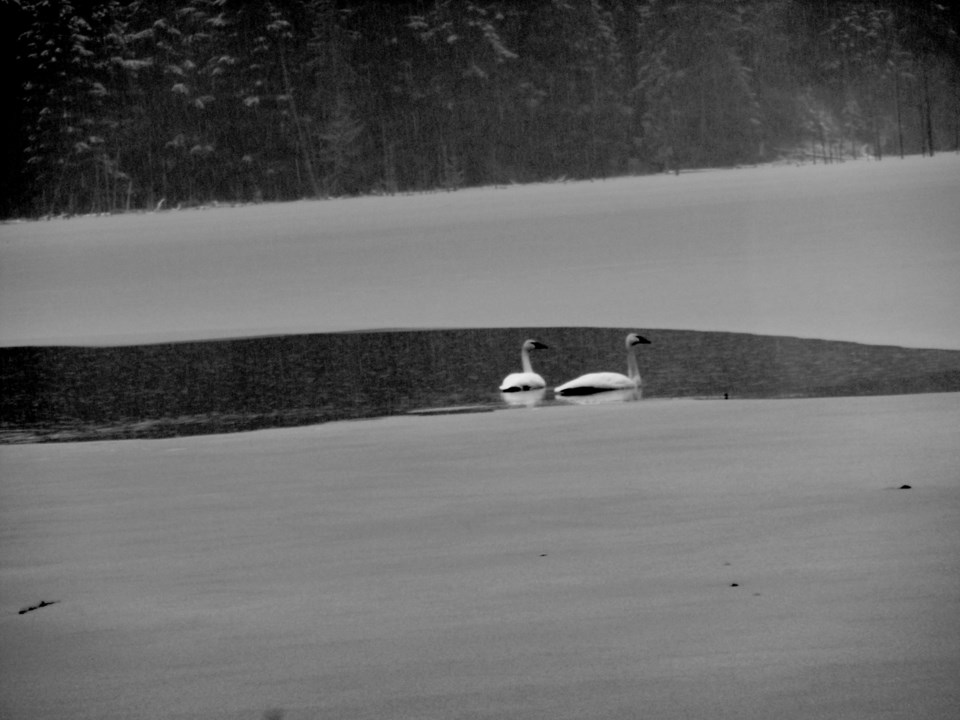Sue Ellen spotted them first: “What the heck are those big white mounds on the lake?” Killarney Lake was mostly frozen and two white mounds were making their way, slowly and cautiously, across the ice to reach open water, one foot occasionally slipping through a thin piece of ice and plunging into the water. Trumpeter Swans. They had come south for the winter to escape the cold and snow of their usual northern tundra habitat. The original snowbird. All white with a long straight neck, black bill and a wingspan of around seven feet, they make an impressive sight. I learned they mate for life – which could be 20 years or more - and they form their pair bond on their wintering grounds. A love match happening right here on Killarney Lake. It was the highlight of a three-hour trek to count birds.
I always look forward to the annual Christmas Bird Count that takes place across North America. It offers us a glimpse into the community of bird life in the winter on Bowen. They call it the Christmas Bird Count but this year it took place on January 4th. When we dashed out of the house last Sunday wearing parkas and boots and told the neighbour we were going to count birds, his response was “Good Lord!” It’s true, it was snowing quite hard. But true bird lovers and citizen scientists do not let that get in the way.
Got the binoculars? Check! Got the thermos? Check! Got the bird book? Two of them. Check! Got the list? Check! The list contains four pages of the birds you’re likely to see. Geese. Ducks of all kinds. Grouse. Grebes. Cormorants. Herons. Raptors such as Eagles and Hawks. The Shorebirds. The Night Birds. The Woodpeckers. The Hummingbirds. The Wrens. The Sparrows. The Thrushes. The Dippers – a particularly entertaining bird that likes to hang out at Bridal Veil Falls. It perches on a rock, bobs up and down several times, and then plunges head first into the rushing water in a sort of kamikaze gesture. You’re sure it’s going to be dragged to its death over the rocks and then, miraculously, it surfaces. To bob and plunge again.
Bird Studies Canada organizes the Christmas Bird Count, bringing eager citizen scientists together to count the many species they find in their neighbourhood. On Bowen, Pam Dicer organized us into territories. The four of us, Paul, Sue Ellen, Will, and I, were sent to Killarney Lake, which meant we would see ducks as well as other feathered friends. Every year, I see something new and learn something unusual about our wonderful community of birds. I appreciate how they add beauty and song to our surroundings. There’s nothing like listening to the “chickadee-dee-dee” call on a dreary day in January to brighten up your day. And I’m grateful for their appetite for insects that would otherwise be gnawing away at my veggies.
Sedentary bird lovers can stay home, if they like, and watch who comes to the feeders. The Bird Count is always a lot of fun and provides important information for bird conservation – and bird conversation. “Did you hear that?” “Sounds like a Kinglet.” “Golden Crowned or Red Crowned?” Discussion follows and the flipping of bird book pages. Sometimes you might find a species unusual to the area, one that has extended its northern edge due to a warming climate. Others are permanent residents and still others are on their way to somewhere else.
Every year has its highlights. A few years ago, we came upon a mature bald Eagle perched on a half-submerged log in Killarney Lake and watched breathlessly as this magnificent bird of prey took a bath. Scooping up water with its gigantic wings, it showered itself with the spray, meticulously cleansing every single feather. No one said a word for 10 minutes. We were silenced by the rare privilege of seeing this majestic bird in such an intimate act of personal hygiene.
The Bird Count is always a wonderful way to begin the New Year and celebrate the community of our feathered friends. Guaranteed to make us realize how fortunate we are to live on an island that supports so many birds. See you at the 2016 Bird Count.



